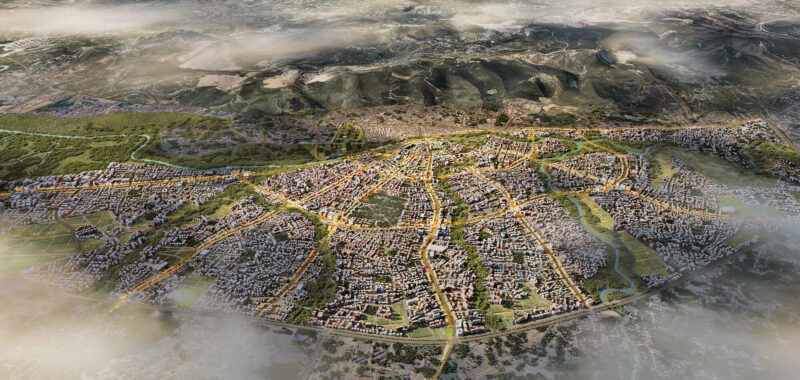Foster + Partners released its speculative reconstruction plan for Antakya, Turkey. The historic capital of Hatay province near the Levantine Sea was decimated by a 7.8 category earthquake in February 2023.
Hatay province’s reconstruction process started in October 2023. That month, a Turkish consortium invited international architects and planners to help rebuild. It was also around that time when Turkish activists and journalists reported that government corruption played a role in the earthquake’s disastrous ramifications. Several of these dissidents were imprisoned and some were given life sentences, as reported by AN.
The new master plan for Antakya aims to retain the city’s historic scale, facade rhythm, and dense street configurations while adding much needed housing and jobs for displaced peoples. Its goal is to also enhance accessibility and inclusivity, Foster + Partners shared, while increasing the city’s resilience against future disaster scenarios.

Buro Happold, MIC-HUB, DB Architects, and KEYM (Urban Renewal Centre) are all development partners in the master plan. The venture is part of a larger project by Türkiye Design Council, an NGO, to jumpstart reconstruction efforts. The Turkish Ministry of Environment, Urbanisation and Climate Change; and Ministry of Culture and Tourism are also involved.
Rebuilding Antakya
Antakya, once called Antioch, was founded in 307 B.C. by the ancient Greeks. Antioch eventually became one of the largest and most important cities along the Silk Road in the Roman, Byzantine, Sasanian, Abbasid, and Mamluk empires. It was later ruled by the Ottoman Empire from 1517 until World War I. Around 1917, French Mandate of Antioch began; that lasted until 1939 when Atatürk annexed the Hatay state in southeast Turkey, and Antioch became Antakya.
Today, more than 80 percent of Antakya has been destroyed by the 2023 earthquake. The city with a population of 400,000 people known for its Ottoman architecture, narrow streets, and Byzantine art lies in a state of ruin.
The reconstruction plan for Antakya is based on eight core design principles, architects shared. First and foremost, all new construction must be built on safe land. This means no new buildings near waterbeds on sites that could be compromised by rising water levels. Toward this end, Foster + Partners envisions green buffers and soft edges to create more space for water runoff.

The second principle entails improving circulation while respecting the existing, historic street grid. The master plan’s road network follows the current pattern that extends from Cumhuriyet Meydani and adds new, strategic connections that promote walkability. Cumhuriyet Meydani itself will be transformed into a pedestrianized and public transport-only zone, Foster + Partners shared.
Thirdly, open spaces along the Asi River and stream edges can be better connected to the city, creating more distributed and diverse options for people to enjoy. The master plan team hopes to realize new city parks, nature walks, community plazas, playgrounds, and pocket parks all throughout Antakya. A new park north of Atatürk Park has also been proposed with views of Mount Habib Neccar, a Biblical mountain range.

Fourthly, and perhaps most presciently, the master plan seeks to create 13 new districts in Antakya, each with its own community infrastructure. The remaining principles entail maximizing quality of life and walkability in Antakya’s districts, new and old.
Rebuilding Trust?
Engaging with local stakeholders was paramount to the Antakya master plan process, designers shared. This need is pronounced because, today in Turkey, many people blame the government for the shoddy construction which led to so many building collapses during the 2023 earthquake.
Dr. Tayfun Kahraman, the former executive board chairman of Turkey’s Chamber of Urban Planners who is now serving an 18-year prison sentence for his anti-corruption activism, described this distrust and negligence in an article for AN shortly after the earthquake struck.

Furkan Demirci, chairman of the Türkiye Design Council, said that the master plan team worked with over 1,000 people to make the reconstruction program. Demirci continued that he hopes the master plan could “set a new standard for post-disaster recovery that puts communities at its heart.”
“Our strategy does not offer a ‘one size that fits all vision.’ It balances the historic spirit of the place with improvements and enhancements that will support a sustainable future for Antakya,” said Bruce Moser, head of urban design at Foster + Partners. “We have developed the vision underpinned by the fact that reconstruction following a natural disaster is not merely about buildings but about rebuilding communities, feelings of safety and belonging, and rebuilding trust.”

